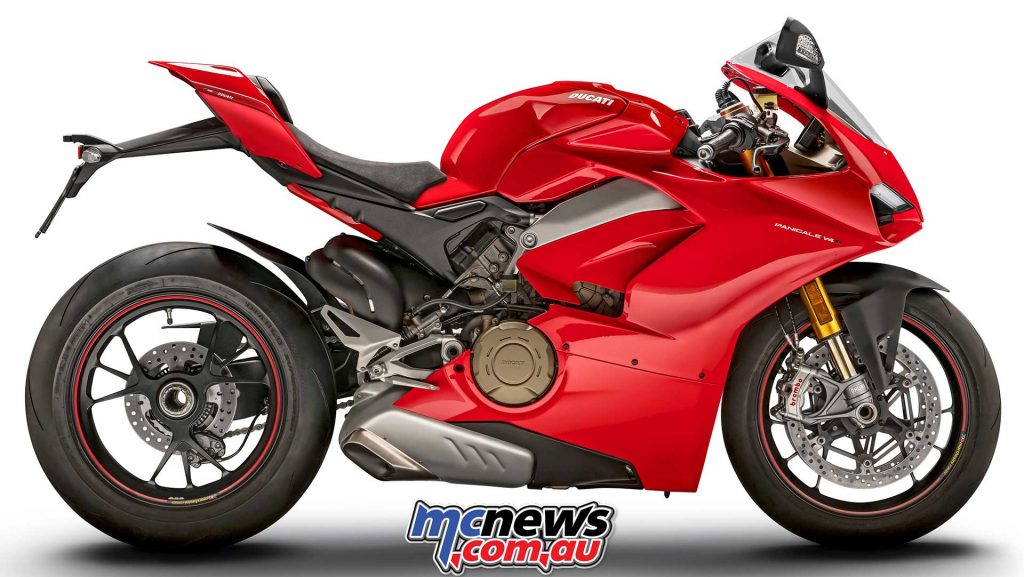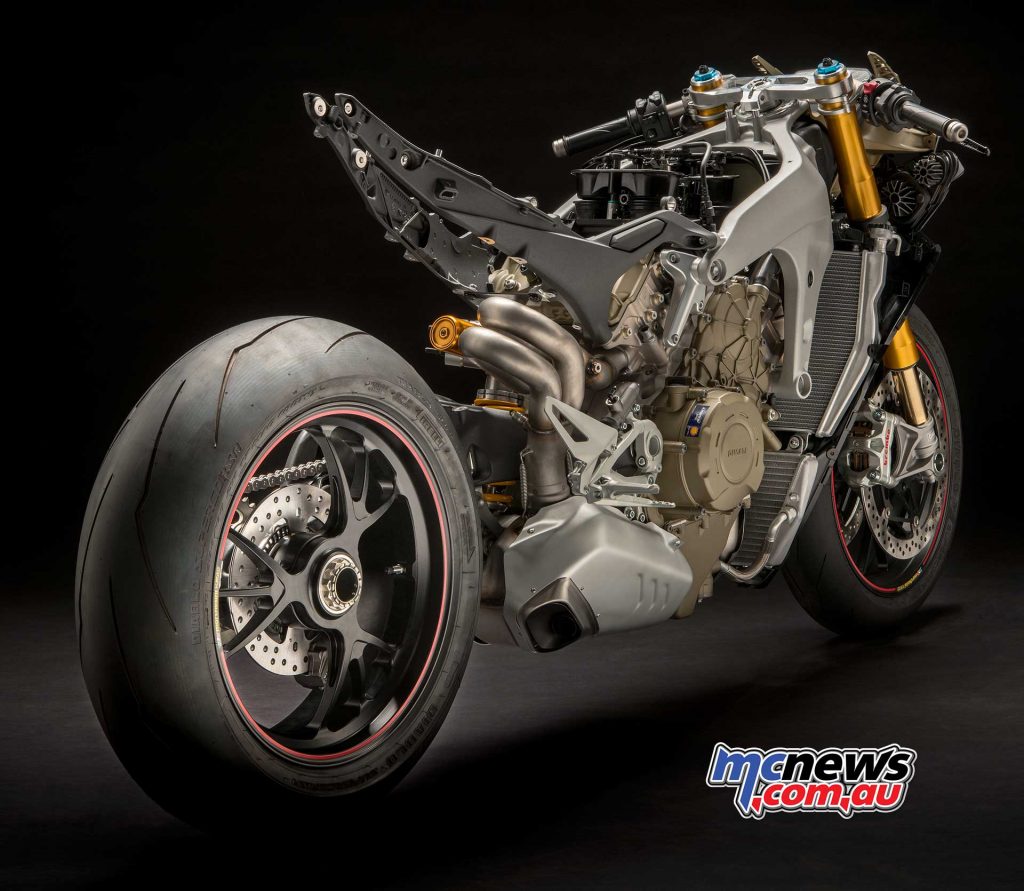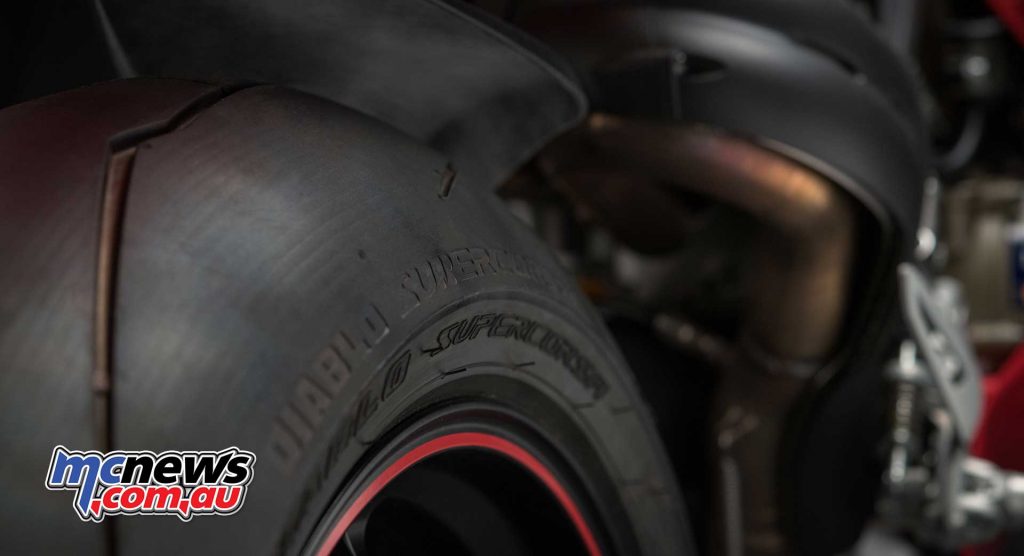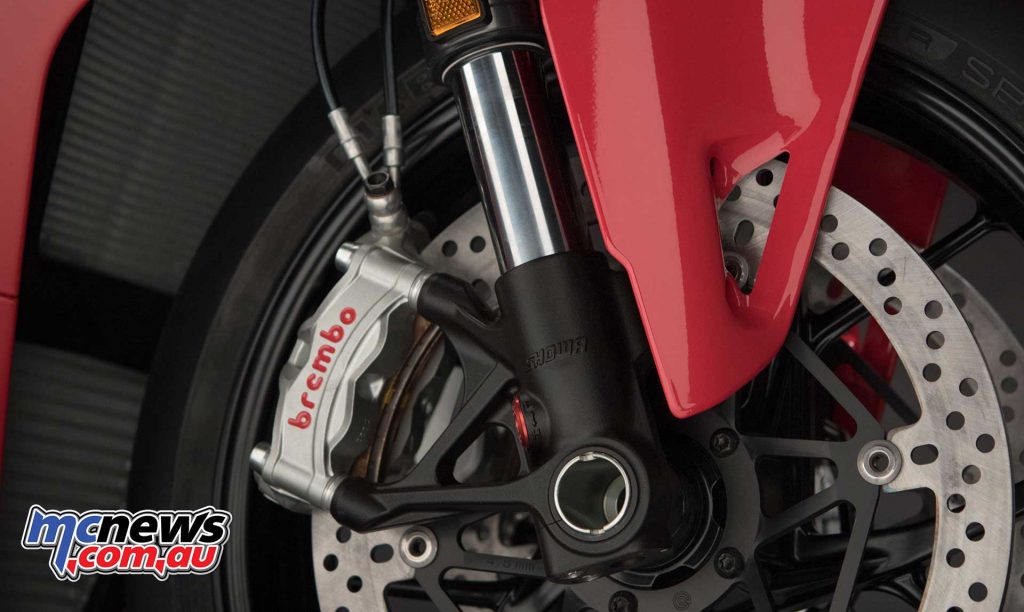Design
The new Panigale V4 was designed by the Ducati Design Center, starting from the 1299 Panigale styling elements and evolving them into a muscular machine, with sleek surfaces and assertive profiles.

The motorcycle’s bodywork develops around the technical parts, and in particular, the new “Front Frame” left exposed, with the two pillars extending laterally to the Desmosedici Stradale cylinder heads. The front is dominated by two large airbox air intakes, which incorporate the full-LED headlight in the top part, overshadowed by the ports. The headlight sizing is reduced with the precise aim of enhancing the
aggressive look of the two oversized ports, especially when the engine is switched off.
Below the air intakes are two wing attachments designed to accelerate the incoming airflow. The full-LED headlight includes a Daytime Running Light outlining with a double-edged profile the top of the air intakes, and two compact LED modules ensuring low-beam and high-beam functions.
The nose fairing is a perfect example of the concept of integration underlying the new Panigale V4 stylistic approach. The front sub-frame, made of magnesium, is partially exposed to become part of the bodywork. The sub-frame also supports the mirrors with LED turn indicators integrated in the outer shell.
The search for essentiality and integration has also led to the dual-layer fairing design: a less stretched out main fairing, and another layer that also acts as an air outtake. The “dual layer” solution emphasises the compact nature of the vehicle mechanics and is inspired by the iconic clean lines of Ducati racing models – traditionally characterised by their stylish fairings. The main fairing extends upward by embracing the tank with two muscular shoulders which, at the top, morph into the cover of the compartment that accommodates easily accessible electrical and electronic components.
The tank has a shape designed to support the rider during track riding and stretches out to below the seat – just like in racing models. This feature is highlighted by exposing the tank in the tail area. The tail is made of two shell-cast aluminium half-shells, which starting from the rear cylinder head, reach out to hug the tank part below the seat, ending up in the single-seater one-piece tail end, whose wing-shaped design is inspired
by the shape of a car spoiler. The tail faring integrates the full LED light that is also wing shaped: although a single piece, it features the signature split lighting typical of Ducati racing models.
Innovative Front Frame
The racing soul of the new Panigale V4 is apparent in its technical specifications including a kerb weight of 195 kg for the “S” and Speciale versions (only 5.5 kg more than the 1299 Panigale S). It would be impossible to achieve these values by using a traditional perimeter frame. For this reason, a “Front Frame” has been developed – using the Desmosedici Stradale engine as a load-bearing feature. This solution is an evolution of the monocoque design and was developed on the strength of the experience gained in MotoGP.
Compared to the Monocoque design, the “Front Frame” allows torsional rigidity and lateral rigidity to be kept separate, so as to obtain the right response to the stress transmitted to the frame and better absorb any road surface roughness in cornering, ensuring the necessary stability. All this results in superior agility and riding precision – ensuring easier control and less fatigue for the Panigale V4 rider.

The main difference in lay-out over traditional perimeter frames is the use of the engine as a structural element of the frame. At just 4 kg, the “Front Frame” features a compact frontal structure, secured directly to the upper half-crankcase of the front cylinder head and to the V4 rear cylinder head, with the engine also acting as a fixing point for the rear suspension and a fulcrum point for the single-sided swingarm.
The most important advantage offered by the Ducati “Front Frame” is that the Desmosedici Stradale engine can be used to achieve the required rigidity, making it possible to significantly reduce the outreach, and consequently, the weight, of the main frame, resulting in a better rigidity/weight ratio. Another plus is the fact that the reduced length of the pillars running alongside the engine has resulted in a more compact
motorcycle design – especially in the rider seat area.
The frame is complemented by the lightweight front sub-frame, made of magnesium, and the shell-cast aluminium seat sub-frame, secured to the “Front-Frame” at the top, and screwed into the top of the rear cylinder head at the bottom.
The rear suspension uses a rising-rate linkage mechanism attached to the Desmosedici Stradale engine via a forged aluminium element. The linkage responds to the motion transmitted by a 600 mm long high triangulation cast aluminium single-sided swingarm, among the longest in the segment, to ensure the best performance riding out of corners.
The rake and trail are 24,5° and 100 mm – respectively.
Sophisticated suspension
The Panigale V4 is equipped with 43 mm Showa Big Piston Forks (BPF), fully adjustable in spring pre-load and compression and rebound damping. The fork bodies house chrome sliders with Brembo radial caliper mountings. A Sachs steering damper completes the front-end package. The rear unit is a fully adjustable Sachs shock, fixed at one end to the Desmosedici Stradale through a forged aluminium element.
The Panigale V4 S and Panigale V4 Speciale are equipped with Öhlins NIX-30 forks, Öhlins TTX36 rear shock and Öhlins steering damper, with an event-based control system. In these versions, the suspension and the steering damper are controlled by the second-generation control system Öhlins Smart EC 2.0, featuring, among other things, the new Objective Based Tuning Interface (OBTi).
Wheels and Tyres
While the Panigale V4 is fitted with 5-spoke cast aluminium wheels, the Panigale V4 S and Speciale feature 5-spoke forged aluminium alloy wheels.
Ducati and Pirelli worked hand in hand to develop the new Panigale V4, the first motorcycle ever to feature as factory equipment the new Pirelli Diablo Supercorsa SP 120/70 ZR17 at the front and the new size 200/60 ZR 17 at the rear. The latest version of the Diablo Supercorsa SP, in the new 200/60 ZR 17 size already popular as a slick option in the FIM World Superbike Championship, is a pioneer in the field of racing replica tyres.

The innovative profile of the resized rear tyre maximises the contact patch at extreme lean angles and makes the most of the bi-compound technology used: the SC2 compound used for the shoulder area is the same used for racing slick products, ensuring the enhanced grip of racing tyres while guaranteeing at the same time the strength and versatility needed for road use. In order to work in perfect harmony with the rear tyre, the front tyre has gone through an extra, major development step: all the riding items related to handling, from rider feedback through support solidity to safety feeling and grip loss predictability, have been optimised by creating a new front profile, slightly increased in terms of maximum section width with respect to the previous version of the product. Redesigning the geometries of the semi-finished products and the belt pattern has made it possible to set new agility and rideability standards, with at the same time top racing level performance. Finally, the new tread pattern of the Diablo Supercorsa SP features a new “flash” geometry to optimise track performance by improving wear, and reduced groove widths designed to provide adequate support for stronger side thrusts.
Exclusive braking system with new Brembo Stylema calipers
The Panigale V4 range is fitted exclusively with the brand new Brembo Stylema monobloc calipers – the latest evolution of the already high-performance M50.

The new Stylema calipers, machined from a single piece of alloy, feature lighter-weight areas in the fixing bushings and in the body, which, compared to the M50, make them visually more compact – allowing at the same time a weight reduction of 70 g for each caliper, without compromising on rigidity. Other improvements have been introduced in terms of internal ventilation to ensure higher efficiency. The new Stylema calipers ensure improved hydraulic performance thanks to their extreme rigidity, which translates into excellent fingertip feel, a shorter brake lever travel and prompt response.
The twin Brembo calipers each have four 30mm pistons that grip 330mm discs to achieve outstanding braking performance – with at the rear a single 245 mm disc with a 2 piston caliper.
The braking system is supported by the ABS Cornering EVO system, which uses the extra-lightweight 9.1MP Bosch control unit.
Racing tank
The Panigale V4’s racing soul is enhanced by the 16 litre lightweight aluminium tank which, just like in racing motorcycles, relocates part of the fuel storage to below the rider’s seat. The space not occupied by the fuel has been used to store all the electronics at front of the tank, under a plastic cover: this includes the battery, which in the Panigale V4 S and Panigale V4 Speciale versions is a lithium-ion pack.























